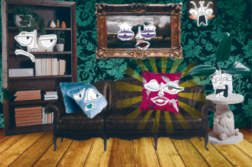I’m allergic to my period.
…yes, you really read that right. I get an allergic reaction to that monthly occurrence that is essentially unavoidable. Every. Single. Time. Now, that’s a pretty extreme opening statement but I bring it up now because, for this article to make sense, we need to begin by establishing two things:
- How much my body hates me and
- How very difficult it is just for me to exist.
So, now that we’ve gotten that fun fact out of the way, let’s take a closer look at how all this works in practice: In short, my allergic reactions are caused by an inexplicable reaction to progesterone. Progesterone is, of course, one of the primary hormones in the female body— and one that’s heavily involved with periods, pregnancy, and all that other fun stuff. So, not only is this hormone already present in the female body, but you also get a new surge of it every month when your period hits.
So, during ‘that time of the month’, the skin on my face grows hot and visibly bright red; it looks— and feels— like I am being scalded from the inside out. I am yet to find a medical-grade moisturiser that can ease the pain. I also develop respiratory symptoms that range somewhere between a cold and the flu; compulsive sneezing, a permanent runny nose, and an inability to breathe, which have all become part of my daily life – that’s in addition to the debilitating cramps that have caused me to faint from sheer pain on more than one occasion.
So, with all that in mind, to say that these experiences are painful and embarrassing would be the understatement of the century. But why did I decide this is something you need to know? Well, you see, that’s because of a little film called Turning Red, and the subsequent backlash it has triggered. If you’re not familiar with the controversy, Turning Red is an animated film which follows the story of a thirteen-year-old girl named Mei, whose experience with puberty is… unconventional, to say the least. That’s because, whenever Mei gets excited, she turns into a giant red panda.
And, as anyone who’s ever been through puberty knows, that time of your life is characterised by an abundance of emotion which would make it pretty easy to spend every day— if not your entire adolescence— as a massive, freaked-out panda. And people don’t seem to mind that aspect of Turning Red; through the magical delights of animated films, we’ve learned to relate to clownfish, to monsters, to cars with eyes, so why not a red panda? Instead, the detail that has enraged some viewers is the fact that Mei’s first period is depicted as one of the range of experiences that impact her emotional development.
Given the amount of outrage over the film, you’d be forgiven for assuming that Turning Red brought American Horror Story levels of gory detail to Mei’s first experience with menstruation. But it doesn’t. The most overt detail you can see is a simple shot of an animated pad and a few tampon boxes that Mei’s mom lovingly brings her as they work through this experience together. Turning Red attempts to provide a very tender and positive representation of female puberty; they offer a portrayal that features support, love, and education for Mei and young female viewers alike.
As I took in this representation, I have to say, that I felt like crying a little bit. Because, although my own mum has been amazing and supportive throughout my own traumatic experience with periods, I’ve never seen such a positive representation on screen before. In fact, I have rarely encountered a film which does not imply that periods— and, by extension, the female body— are repulsive and shameful.
This type of representation is inherently damaging. But it was especially toxic for someone like me— a neurodivergent girl who started her period at a very young age and quickly realised that the tumult of puberty was not the only traumatic change she would be forced to contend with. So, not only was this experience conflicting and confusing for me, due to the representation I absorbed as a child, I struggled to talk about what was going in with my body. I avoided talking to friends about my experiences for fear of immediately being labelled as gross or dirty.
Today — at the age of twenty-five — my health issues dominate my life so much, that it is literally impossible to avoid speaking about them. For example, it is beyond awkward to cancel meetings with my PhD supervisor for no reason or offer my mates no explanation as to why I acted so weird out of nowhere. So, I’ve had to talk about my period. I’ve had to be honest about my symptoms. And much to my surprise, this has actually been very helpful.
It’s allowed me to start a conversation about conditions that are underrepresented and stigmatised, often to the extreme detriment of women who live with them. And by being open about my experiences, I’ve had the opportunity to encourage others to speak up about similar issues such as their damaging experiences with endometriosis and the side-effects of birth control.
And I think that’s so important because conditions like endometriosis are still woefully understudied and misrepresented, to say nothing of my condition; as a general rule, most medical professionals are unfamiliar with the concept of someone being allergic to their period. And that’s exactly why I think Turning’s Red representation is so important. Films like Turning Red embody a shift in the cultural conversation— one where the female body is not treated as shameful, and where women can speak freely about their bodies and the struggles they experience.
Thus, I see Turning Red as a beacon of hope: a glimmering possibility that young girls in the future will be able to engage with on-screen representations that empower them to learn more about their bodies and speak up without shame when something feels wrong.



